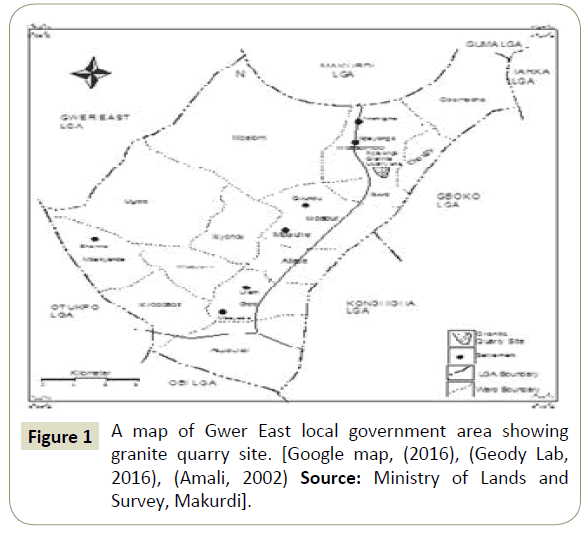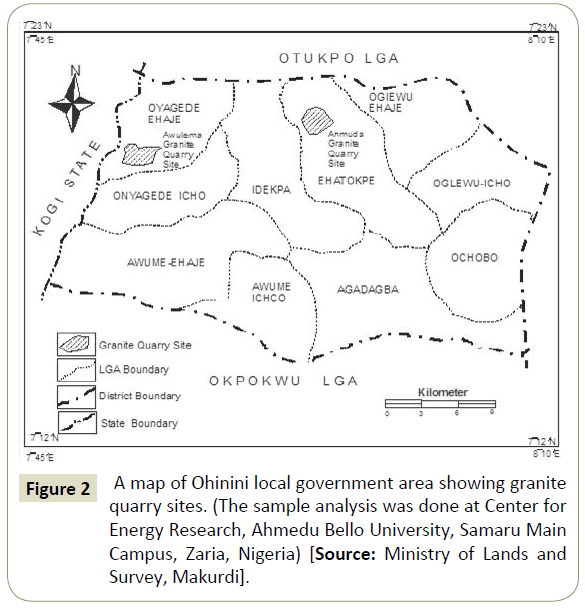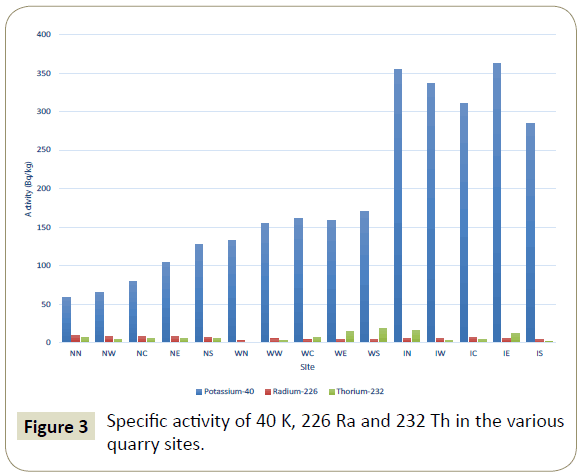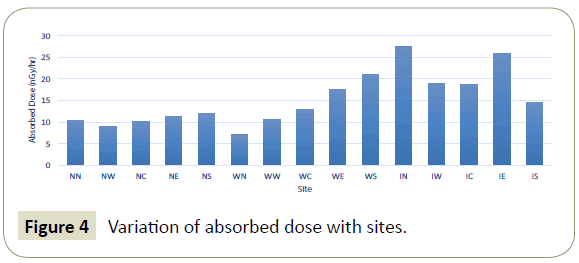Assessment of Radionuclides in Selected Granite Quarry Sites within Ohimini and Gwer - East Local Government Areas of Benue State in Nigeria
Omenka S Ode1, Ige TA2 and Sombo T3
Omenka S Ode1*, Ige TA2 and Sombo T3
1Department of Physics, Benue State University, Nigeria
2Department of Medical Physics, Clinical Services, National Hospital, Abuja, Nigeria
3Department of Physics, University of Agriculture, P.M.B 2373 Makurdi, Benue State, Nigeria
- *Corresponding Author:
- Omenka S. Ode
Department of Physics
Benue State University
P.M.B 102119 Makurdi, Benue State
Nigeria
Tel: +234-7033326160
E-mail: odesammy@gmail.com
Received date: October 17, 2017; Accepted date: October 27, 2017; Published date: October 31, 2017
Citation: Ode OS, Ige TA, Sombo T (2017) Assessment of Radionuclides in Selected Granite Quarry Sites within Ohimini and Gwer - East Local Government Areas of Benue State in Nigeria. Insights Med Phys. Vol.2 No.3:11
Abstract
The assessment of radionuclides in selected granite quarry sites in Ohimini and Gwer-East Local Government Areas of Benue State was carried out using a 76 × 76 mm NaI (TI) detector crystal optically coupled to a photomultiplier tube (PMT). The detector is enclosed in a 6 cm lead shield with cadmium and copper sheet and data acquisition was done by Canberra Nuclear Products (Meastro) at Center for Energy Research Training, Ahmadu Bello University, Zaria. These sites include Anmuda, Awulema and Ikpayongo quarry sites with five samples from each site making a total of fifteen samples. From the preliminary investigation, the mean absorbed dose in Anmuda, Awulema and Ikpayongo are 12.3 nGy/h, 17.27 nGy/h and 18.87 nGy/h respectively and the corresponding Mean Annual Effective Dose equivalent are 0.15 mSv/y, 0.21 mSv/y and 0.25 mSv/y which are actually below the recommended safe values. The result of the assessment of radionuclides in granite samples includes Radium-226 (226Ra), Thorium-232 (232Th) and Potassium-40 (40K). The mean activity concentration in Anmuda for 40K is 86.717 ± 4.656 Bq/kg, that of 226Ra is 7.862 ± 3.728 Bq/kg and 232Th is 5.280 ± 1.505 Bg/kg, in Awulema, 40K is 155.656 ± 5.074 Bq/kg, 226Ra is 3.614 ± 4.220 Bq/ kg and 232Th is 8.478 ± 3.842 Bq/kg and in Ikpayongo 40K is 329.737 ± 9.405 Bq/kg, 226Ra is 5.394 ± 5.032 Bq/kg and 232Th is 7.067 ± 3.820 Bq/kg. The mean absorbed dose in Anmuda, Awulema and Ikpayongo are 10.6094 nGy/h, 13.845 nGy/h and 21.212nGy/h. The mean annual effective dose equivalent in Anmuda is 0.13 mSvy- 1, Awulema is 0.16 mSvy-1 and Ikpayongo is 0.25 mSvy-1. The average value falls within the global range of outdoor radiation exposure given by UNSCEAR-2000 publication
Keywords
Radionuclides; Granite quarry; Activity concentration; Absorbed dose; Annual effective dose and radiation hazards
Introduction
Radiation is defined as the transfer of energy through space and matter in the form of wave and particle. Natural and artificial sources of ionizing radiation are present in the environment in which we live. Naturally occurring radionuclides are present in air we breathe, the food we eat and the water we drink and have resulted in adverse health consequences on the public. Human can be exposed to radionuclide from natural and artificial sources through human activities such as mining and drilling [1]. The artificial sources also include human activities such as nuclear and atomic bomb testing, nuclear reactor explosions, mining activities, industrial waste and effluent from factories as reported by Agba et al. in 2006. International Atomic Energy Agency (IAEA) estimation shows that over 85% of radiation dose received by man are derived from the naturally occurring radionuclides while the remaining 15% is from cosmic rays and nuclear processes all around the globe [2]. Over exposure to radiation could cause adverse health effects such as leukemia, chromosomal breakage, bone necrosis, bone cancer, mutation of genes, cataracts of eye lens etc. The mining of mineral resources such as granite, limestone, marbles etc can facilitate the release of radioactive materials from the host material (ores) into the environment since most minerals (ores) co-exist with naturally occurring radionuclides [3].
On the earth, natural radioactive mineral deposits are available in many suitable geological environments [4]. The high exposure level of these radionuclides in such an area may be harmful to people residing in the region. The greatest contribution to human exposure comes from natural background radiation [5].
The energy transferred by ionizing radiation to the mass per unit volume, is called absorbed dose. The probability of affecting the human health is directly related to the absorbed dose. The worldwide average natural dose to humans is about 2.4 mSv per year (UNSCEAR, 2000).
The major natural radionuclides of concern are Thorium-232 (232Th) and Radium-226 (226Ra) and their decay products as well as Potassium-40 (40K). Thorium and Uranium primarily undergo alpha and beta decay and are not easily detectable. However, many of their daughter products are strong gamma emitters. Gamma rays are more penetrating than alpha or beta particles and are most often used to characterize the terrestrial component of the natural radiation environment. Thus, the gamma ray emissions from 232Th and 238U radioactive daughter products are used to estimate their concentrations [6].
Granite is the best-known igneous rock which has extensive applications. Granite is used to make many objects that we encounter in life daily. These include counter tops, floor tiles, paving stone, stair, building veneer, and cemetery monuments [7]. At the same time granite is a natural source of radioactivity like most natural rocks. The main part of the radioactivity in this kind of samples is attributed to the potassium-40 radioisotope. 40K exists in a standard relation with total potassium content, with a natural abundance of 0.012%. Granites contain also some dozens of parts per million (ppm) of Uranium and Thorium as well [8].
Granite quarries produce massive amount of dust particles and such dust particles increase the level of Radon gas [9]. The main way of saving the humans from radiation injuries is to protect it from exposure to radiation and this is why radiation monitoring and measurement are very essential in our society today [10].
Experimental Procedure (Methodology)
Description of study area
The description of study area is shown in Table 1 as well as Figures 1 and 2.
| S/No | Location | Bearing | Latitude | Longitude |
|---|---|---|---|---|
| 1 | Anmuda | 249o | 7.193o | 8.09166o |
| 2 | Awulema | 262o | 7.22315o | 8.09166o |
| 3 | Ikpayongo | 288o | 7.58157o | 9.69039o |
Table 1: Sample location and their coordinate in Gwer-East and Ohimini Local Government.
Sample collection
Five samples of granite were collected each from Anmuda and Awulema quarry sites both in Ohimini local Government Area, similarly samples of granite were collected from Ikpayongo quarry site in Gwer-East Local Government area making a total of fifteen samples.
The collected samples were sun-dried and pulverized to 1 mm2 mesh sizes with a jaw crusher and ceramic mortar, and then homogenized to obtain a fine texture powder that gave a uniform matrix to the detector. The mass of each of the final powdered samples that was used for the analysis was 350 g. The packaging of the samples into radon-impermeable cylindrical plastic containers which were selected based on the space allocation of the detector vessel which measures 7.6 cm × 7.6 cm in dimension (geometry) was also carried out. To prevent radon-222 escaping, the packaging in each case was triple sealed. The sealing process included smearing the inner rim of each container lid with Vaseline jelly, filling the lid assembly gap with candle wax to block the gap between lid and container, and tight-sealing lid-container with masking adhesive tape. Radon and its short-lived progenies were allowed to reach secular radioactive equilibrium between precursor and progeny radionuclides by storing the samples for 30 days prior to gamma spectroscopy measurement [11].
Evaluation of radioactivity of sample and the dose
The analysis was carried out using a 76 × 76 mm NaI (TI) detector crystal optically coupled to a photomultiplier tube (PMT). The assembly has a preamplifier incorporated into it and a 1kilovolt external source. The detector is enclosed in a 6 cm leadshield with cadmium and copper sheet. This arrangement is aimed at minimizing the effects of background and scattered radiation.
The calibration of the system for energy and efficiency were done with two calibration point sources, Cs-137 and Co-60. These were done with the amplifier gain that gives 72% energy resolution for the 66.16KeV of Cs-137 and counted for 30 minutes.
The data acquisition was done by Canberra Nuclear Products (Meastro). The samples were measured for a period of 29000 seconds each. The peak area of energy in the spectrum was used to compute the activity concentration in each sample by using the following equation:
C (Bq/kg) = Cn/Cfk …………………………………………… (1)
Where:
C = Activity concentration of the radionuclides in the sample given in BqKg-1
Cn = Count rate (counts per seconds) count per second (cps) = Net count/ live Time.
Cfk= Calibration factor of the detecting system which is the product of the efficiency of the detector, the intensity of the gamma line in the radionuclide and the mass of the sample.
The actual concentration is gotten after deducting the reduction factor for each radionuclide given as; 12.3 Bq/kg for 226Ra, 15.5 Bq/kg for 232Th and 18.5 Bq/kg for 40K [12].
The absorption dose was calculated based on guidelines provided by ICRP-60 using the following relation;
Do = 0.427 CRa + 0.662 CTh + 0.043 Ck……………………………… (2)
Where;
CRa, CTh and Ck are the activity concentration of 226Ra, 232Th and 40K 0.427, 0.662 and 0.043 are dose conversion factor for 226Ra, 232Th and 40K by the new ICRP dosimetric setting [13].
The Annual Effective Dose Rate can be estimated by taking into account the conversion coefficient from the absorbed dose in air to the effective dose in air (0.7SvGy-1) and an outdoor occupancy factor of 0.2 received by adults. The annual effective dose equivalent was calculated by the following equation [14].
E (mSvy-1) = D (nGyh-1) × 8760 (h) × 0.2 × 0.7 (mSvy-1) × 10-6……………………………… (3)
Result and Discussion
The following tables show a comparative result of the radioactivity measured in terms of dose rate and exposure in different locations within the three quarry sites (Tables 2-4).
| S/No | Sample code | 40K (Bq/kg) | 226Ra (Bq/kg) |
232Th (Bq/kg) |
|---|---|---|---|---|
| 1 | NN | 58.016 ± 3.736 | 9.016 ± 3.475 | 6.164 ± 1.140 |
| 2 | NW | 65.787 ± 3.287 | 7.712 ± 3.455 | 4.534 ± 1.772 |
| 3 | NC | 78.930 ± 3.324 | 7.601 ± 3.212 | 5.287 ± 1.621 |
| 4 | NE | 103.939 ± 4.332 | 7.578 ± 3.982 | 5.482 ± 1.921 |
| 5 | NS | 126.912 ± 8.600 | 7.394 ± 4.518 | 5.138 ± 1.071 |
| 6 | WN | 132.977 ± 4.417 | 2.297 ± 4.286 | 0.577 ± 2.052 |
| 7 | WW | 155.021 ± 4.908 | 4.683 ± 4.445 | 2.838 ± 3.112 |
| 8 | WC | 160.933 ± 4.546 | 3.554 ± 4.219 | 6.790 ± 2.891 |
| 9 | WE | 158.715 ± 5.902 | 3.735 ± 5.134 | 13.820 ± 2.936 |
| 10 | WS | 170.635 ± 5.599 | 3.803 ± 3.012 | 18.365 ± 8.233 |
| 11 | IN | 354.595 ± 10.264 | 5.193 ± 4.402 | 15.286 ± 3.192 |
| 12 | IW | 336.690 ± 9.328 | 5.938 ± 4.523 | 2.943 ± 2.277 |
| 13 | IC | 310.956 ± 9.760 | 6.473 ± 5.451 | 4.043 ± 3.754 |
| 14 | IE | 362.780 ± 10.673 | 5.342 ± 5.920 | 12.043 ± 3.841 |
| 15 | IS | 284.035 ± 6.998 | 4.023 ± 4.865 | 1.019 ± 2.280 |
Table 2: The radionuclides and their corresponding activity concentrations.
| S/No | Sample Code | Absorbed dose (nGyh-hr) |
|---|---|---|
| 1 | NN | 10.425 |
| 2 | NE | 9.123 |
| 3 | NC | 10.140 |
| 4 | NW | 11.333 |
| 5 | NS | 12.026 |
| 6 | WN | 7.081 |
| 7 | WE | 10.525 |
| 8 | WC | 12.933 |
| 9 | WW | 17.568 |
| 10 | WS | 21.119 |
| 11 | IN | 27.583 |
| 12 | IE | 18.961 |
| 13 | IC | 18.812 |
| 14 | IW | 25.853 |
| 15 | IS | 14.606 |
Table 3: The absorbed dose in the quarry sites.
| S/No | Sample Code | Annual Effective Dose (mSvy-1) |
|---|---|---|
| 1 | NN | 0.128 |
| 2 | NE | 0.112 |
| 3 | NC | 0.124 |
| 4 | NW | 0.139 |
| 5 | NS | 0.147 |
| 6 | WN | 0.087 |
| 7 | WE | 0.129 |
| 8 | WC | 0.158 |
| 9 | WW | 0.215 |
| 10 | WS | 0.259 |
| 11 | IN | 0.338 |
| 12 | IE | 0.233 |
| 13 | IC | 0.231 |
| 14 | IW | 0.317 |
| 15 | IS | 0.179 |
Table 4: The annual effective dose in the quarry sites.
Graphical representations
Below are Figures 1 and 2 showing graphical representation of the specific activity, the absorbed dose and the annual effective dose in the various quarry sites respectively (Figures 3 and 4).
Conclusion
The result of the assessment of radionuclides in granite samples are 226Ra, 232Th and 40K. The mean activity concentration in Anmuda of 40K is 86.717 ± 4.656 Bq/kg, 226Ra is 7.862 ± 3.728 Bq/ kg and 232Th is 5.280 ± 1.505 Bg/kg. In Awulema 40K is 155.656 ± 5.074 Bq/kg, 226Ra is 3.614 ± 4.220 Bq/kg and 232Th is 8.478 ± 3.842 Bq/kg. In Ikpayongo 40K is 329.737 ± 9.405 Bq/kg, 226Ra is 5.394 ± 5.8.032 Bq/kg and 232Th is 7.067 ± 3.820 Bq/kg. The activity concentrations are lower than the worldwide average value of 420 Bq/kg, 33 Bq/kg and 45 Bq/kg for 40K, 226Ra and 232Th recommended by UNSCEAR [15]. 40K is a beta decay radionuclide, 226Raand 232Th are alpha decay radionuclides.
The mean absorbed dose in Anmuda, Awulema and Ikpayongo are 10.6094 nGy/h, 13.845 nGy/h and 21.212 nGy/h which are all lower than 30-70 nGy/h by UNSCEAR [16].
The mean annual effective dose equivalent in Anmoda is 0.13 mSvy-1, Awulema is 0.16 mSvy-1 and Ikpayongo is 0.25 mSvy-1. The annual effective dose rates in the three samples are lower than the recommended 0.50 mSvy-1 by Ajayi, Ibikunle and Baba et al. [17-19].
40K contributes the most in all the three sites follow by 226Ra in Anmuda and Ikpayongo but the contribution of 232Th is more than that of 226Ra in Awulema. The percentage contribution to the absorbed dose of 40K, 226Ra and 232Th in Anmuda are 86.8%, 7.8% and 5.3%. The percentage contribution to the absorbed dose of 40K, 226Ra and 232Th in Awulema is 92.7%, 2.2% and 5.1% and the percentage contribution to the absorbed dose of 40K, 226Ra and 232Th in Ikpayongo is 96.3%, 1.6% and 2.1% respectively [20-22]. The activity concentration shows variations from sample to sample which may be attributed to the granite type (the geological characteristics of the area where the granite was extracted). It should be noted that, the main contribution in the specific activity of each sample due to 40K is high because of the high concentration in potassium in the sample and the surrounding. The average units of all the calculated radiological indices extracted from those activities and the absorbed dose in all the investigated samples are within the level recommended by UNSCEAR 2000 report [23-25].
References
- Arogunjo MA, Farai IP, Fuwape IA (2004) Impact of oil and gas industry to the natural radioactivity distribution in the delta region of Nigeria. Nig Journal Phys 16: 131-136.
- Agba EH, Onjefu SA, Ugwuanyi JU (2006) Preliminary Investigation of the Ambient Radiation Level of Mining Sites in Benue State, Nigeria. Nigeria J Phys 18: 219.
- Paul JE, Mohammad AR, Sodee DB (1978) Nuclear medicine technology. (3rd edn), Macmillan Educational Limited, London. pp: 287-393.
- Bhaumik BK, Bhattacharya T, Acharyulu APSR, Srinivas D, Sandilya MK (2004) Principles of Radiation in radioactive metals exploration. Physics Lab Eastern Region AMD Complex Jamshedpur, India. p. 292.
- UNSCEAR (2000) Sources, effects and risk of ionizing radiation. United Nations Scientific committee in Effect of Atomic Radiation report to the General Assembly, with Annexes, New York, USA.
- Ibrahim U, Akpa TC, Daniel IH (2013) Assessment of radioactivity concentration in soil of some mining areas in central Nassarawa State Nigeria. Sci World J 8: 2.
- https://geology.com/rocks/granite.shtml
- International Atomic Energy Agency (1986) Facts about Low Level Radiation Exposure, IAEA Publications No. A.N.E 985-06482. Culled from Agba E et al. in 2006.
- https://www.radiationanswers.org/
- Goggle Map (2016) Ikpayongo Benue State Nigeria. 1600 Amphitheatre Parkway Mountain View, CA 94043 USA.
- United State General Administration Services (2016) Granite: Characteristics, uses and problems. Retrieved on 25/07/2016.
- Avwri GO, Onunugbo CP 2009 Natural Radioactivity level in Surface Soil of Ogba and Egbema/Ndoni Oil and Gas fields. Energy sci tech 4: 92-101.
- ICRP-60 (1991) International Commission on Radiation Protection Recommendations of the International commission on Radiological Protection. Ann ICRP 21:1-2.
- UNSCEAR (2000) Exposure from natural radiation sources. United Nations Scientific Committee on the effect of Atomic radiation. Report to general assembly. Annex B exposure from natural radiation sources. United Nations, New York.
- UNSCEAR (1998) Ionizing radiation. Report to General Assembly, with Scientific Annexes, United Nations, New York, USA.
- UNSCEAR (2000) Sources and effects of ionizing radiation. Report to General Assembly, with Scientific Annexes, United Nations, New York, USA.
- Ajayi OS, Ibikunle SB (2013) Radioactivity of surface soils from Oyo State, South Western Nigeria. Int J Radiat Res 11:4.
- www.examples.yourdictionary.com/example-of-radiation
- Baba A, Erees FS, Bassari U, Hicsonmez U, Cam S (2013) Natural radioactivity and metal concentration in soil sample taken along the Izmri-Ankara E-023 highway, Turkey. A publication of Canakkale Onsekiz Mart University, Engineering and Architecture Faculty, Geological Engineering Department, 17020 Canakkle-Turkey.
- https://www.reseachgate.net
- Hussain H (2014) Natural radioactivity in soil around the uranium mine in Abu-Skhair Najaf province, Iraq. Adv Appli Sci Res 5:13-17.
- Jibiri N, Temaugee ST (2013) Radionuclide content in raw minerals and soil samples and the associated radiological risk from some mining sites in Benue State, North-Central Nigeria. Int J Sc & Eng Res 4: 7.
- Najat KM, Mohammed SM (2013) Natural radiactivity in soil and water from Likuyu village in the neighbourhood of Mkuju Uranium Deposit. Int J Analy Chem p: 1-4.
- Mira P, Vasileiadou S, Savidou A (2016) Teaching natural radioactivity using samples of granite. Conference paper, International Scientific Conference eRA – 11, Greece.
- Science Buddies (2011) An introduction to radiation and radiation safety. Sobrato Center for non-profits 560 Valley Way Milpitas, CA 95035.
Open Access Journals
- Aquaculture & Veterinary Science
- Chemistry & Chemical Sciences
- Clinical Sciences
- Engineering
- General Science
- Genetics & Molecular Biology
- Health Care & Nursing
- Immunology & Microbiology
- Materials Science
- Mathematics & Physics
- Medical Sciences
- Neurology & Psychiatry
- Oncology & Cancer Science
- Pharmaceutical Sciences




